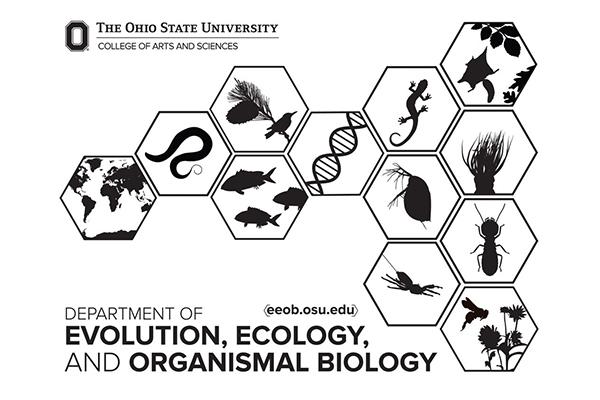EEOB Publications August 1 - August 31

Which factors determine the long-term effect of poor early-life nutrition? A meta-analytic review.
Almeida, L. Z., S. M. Hovick, S. A. Ludsin, and E. A. Marschall. 2021. Ecosphere 12(8):e03694. 10.1002/ecs2.3694
Abstract
Early-life conditions can have long-lasting effects (experiential legacies) on an individual’s performance. Experiential legacies are an important source of variation among mature individuals becauseresponses to early-life environments vary widely. Yet, the factors influencing the magnitudes and directions of phenotypic responses to experiential legacies are poorly understood, hindering our ability to predict adult phenotypes and population-level consequences of environmental stressors. To better understandthese issues, we examined how experiential legacies varied with the type of phenotypic response (e.g., reproduction, longevity), characteristics of the individual, and characteristics of the stressful conditions imposed. We conducted a meta-analytic review (nspecies = 65, nstudies = 81), examining experiential legacies of early-life nutritional restriction. We found generally consistent negative or neutral impacts of early nutritional stress on later-life phenotypes, indicating that positive responses to early nutritional restriction may be rare among organisms. Our results also demonstrated differences in how experiential legacies were expressed in specific dimensions of an individual’s phenotype; for example, magnitude and direction differed among responses in development rate (weak negative response), offspring quality and quantity (strong negative), and longevity (neutral response). We also found that the harsher the early-life nutritional stress, the stronger the negative nutritional legacy. Our results emphasize the complicated interactions among a suite of phenotypic responses in determining individual performance. Given the potential for individual performance to inform the demography and dynamics of populations, we offer avenues for future research that can improve our understanding of how experiential legacies of nutrition or other early-life conditions affect populations.
Fine-scale variation in microhabitat conditions influence physiology and metabolism in an Antarctic insect
Drew Evan Spacht, Josiah D. Gantz, Jack J Devlin, Eleanor A. McCabe, Richard E. Lee, David L. Denlinger, Nicholas M. Teets. 2021. DOI: https://doi.org/10.21203/rs.3.rs-642751/v1
Abstract
Microhabitats with distinct biotic and abiotic properties exist within landscapes, and this microhabitat variation can have dramatic impacts on the phenology and physiology of the organisms occupying them. The Antarctic midge Belgica antarctica inhabits diverse microhabitats along the Western Antarctic Peninsula that vary in macrophyte composition, hygric qualities, nutrient input, and thermal patterns. Here, we compare seasonal physiological changes in five populations of B. antarctica living in close proximity but in different microhabitats in the vicinity of Palmer Station, Antarctica. Thermal regimes among our sample locations differed in both mean temperature and thermal stability. Between the warmest and coldest sites, seasonal mean temperatures differed by 2.6˚C and degree day accumulations above freezing differed by a factor of 1.7. Larval metabolic and growth rates varied among the sites, and adult emergence occurred at different times. Distinct microhabitats also corresponded with differences in body composition, as lipid and carbohydrate content of larvae differed across sites. Further, seasonal changes in carbohydrate and protein content were dependent on site, indicating fine-scale variation in the biochemical composition of larvae as they prepare for winter. Together, these results demonstrate that variation
in microhabitat properties influences the ontogeny, phenology, physiology, and biochemical makeup of midge populations living in close proximity. These results have implications for predicting responses of Antarctic ecosystems to environmental change.
Integrative Taxonomy of Dermacentor variabilis (Ixodida: Ixodidae) with Description of a New Species, Dermacentor similis n. sp.
Paula Lado, Mael G. Glon, and Hans Klompen. Journal of Medical Entomology, XX(X), 2021, 1–12
Abstract
Dermacentor variabilis is the most widely distributed three-host tick in North America, and transmits a variety of pathogens. Within the United States, this species has a discontinuous distribution, widespread east of the Rocky Mountains and with a few populations west of the Rockies. Phylogenetic evidence based on individual markers or relatively small data sets has suggested that populations at both sides of this geographic barrier may correspond to two different species. In this study, we further explore this hypothesis using an integrative taxonomy framework. Both molecular (mitochondrial and nuclear markers) and morphological analyses of specimens collected from central-eastern and western states were performed to explore species delimitation in this taxon. Results from these analyses were consistent, and provide strong evidence that D. variabilis actually corresponds to two species. Herein, the western populations are described as a new species, Dermacentor similis n. sp. The usefulness of integrative taxonomy in the context of species delimitation is also discussed.
Microbiome reduction prevents lipid accumulation during early diapause in the northern house mosquito, Culex pipiens pipiens
Elise M.Didion, Zakee L.Sabree, Laura Kenyon, Gabriela Nine, Richard W. Hagan, Sema Osman, Joshua B. Benoit. Journal of Insect Physiology, 2021, 104295, ISSN 0022-1910. https://doi.org/10.1016/j.jinsphys.2021.104295
Abstract
The mosquito microbiome is critical to multiple facets of their biology, including larval development and disease transmission. For mosquitoes that reside in temperate regions, periods of diapause are critical to overwintering survival, but how the microbiome impacts this state is unknown. In this study, we compared the midgut microbial communities of diapausing and non-diapausing Culex pipiens and assessed how a reduced midgut microbiome influences diapause preparation. High community variability was found within and between non-diapausing and diapausing individuals, but no specific diapause-based microbiome was noted. Emergence of adult, diapausing mosquitoes under sterile conditions generated low bacterial load (LBL) lines with nearly a 1000-fold reduction in bacteria levels. This reduction in bacterial content resulted in significantly lower survival of diapausing females after two weeks, indicating acquisition of the microbiome in adult females is critical for survival throughout diapause. LBL diapausing females had high carbohydrate levels, but did not accumulate lipid reserves, suggesting an inability to process ingested sugars necessary for lipid accumulation. Expression patterns of select genes associated with mosquito lipid metabolism during diapause showed no significant differences between LBL and control lines, suggesting transcriptional changes may not underlie impaired lipid accumulation. Overall, a diverse, adult-acquired microbiome is critical for diapause in C. pipiens to process sugar reserves and accumulate lipids that are necessary to survive prolonged overwintering.
